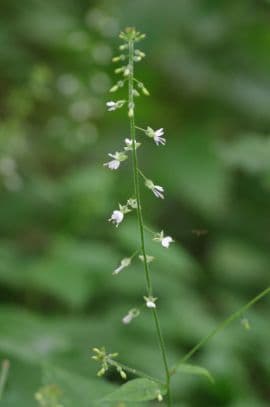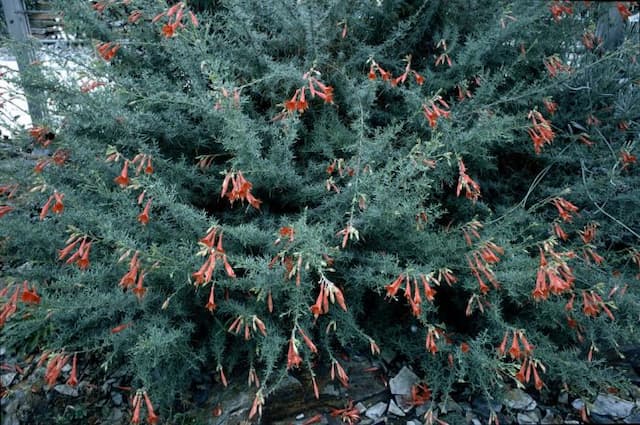Fuchsia 'Bella Sophia' Fuchsia 'Sophia' (PBR) (Bella Series)

ABOUT
A deciduous, tender shrub, compact in growth at no more than 40cm in height and suits containers and baskets especially well. It would make a good edging plant too. The pale pink and white flowers are less pendulous than many bedding fuchsias, emerging upwards and outwards. You can expect blooms from summer through to autumn.
About this plant
 Names
NamesFamily
Onagraceae
Synonyms
Bella Fuchsia 'Sophia', Lady's Eardrops
Common names
Fuchsia 'Sophia' (PBR) (Bella Series).
 Characteristics
CharacteristicsLife cycle
Perennials
Foliage type
Deciduous
Color of leaves
Green
Flower color
Mixed
Height
1 foot (30 cm)
Spread
1 foot (30 cm)
Plant type
Shrub
Hardiness zones
9
Native area
Central America
Benefits
 General Benefits
General Benefits- Ornamental Appeal: Produces vibrant and colorful tubular-shaped flowers that are aesthetically pleasing.
- Long Blooming Period: Typically flowers throughout the summer months and into early autumn, providing extended color in the garden.
- Attracts Wildlife: The blooms can attract hummingbirds and other pollinators, which are beneficial for the ecosystem.
- Versatility: Can be planted in a variety of settings such as hanging baskets, containers, and borders, making it suitable for different garden designs.
- Compact Growth: Its manageable size makes it ideal for small gardens or spaces where larger varieties cannot be accommodated.
 Medical Properties
Medical PropertiesThis plant is not used for medical purposes.
 Air-purifying Qualities
Air-purifying QualitiesThis plant is not specifically known for air purifying qualities.
 Other Uses
Other Uses- Fuchsia 'Sophia' petals can be crystallized and used as elegant edible decorations on cakes and desserts, providing a touch of vibrant color and a slight tanginess.
- The fuchsia plant can be used in fantasy-themed gardens to enhance the magical ambiance with its bell-shaped flowers and striking coloration.
- Artists may use fuchsias as natural models for botanical illustration and paintings, capturing their unique form and color palette.
- Fuchsias can be incorporated into homemade potpourris, with their dried flowers adding color and a mild scent to the mixture.
- The blossoms are suitable for creating natural dyes that can impart pinks and purples onto fabrics or paper, for an organic artistic touch.
- Fuchsia leaves can be used in crafts for making impressions in clay or plaster, leaving a delicate texture inspired by nature.
- The nectar-rich flowers can be floated in water to create a decorative centerpiece that also attracts butterflies if placed outdoors.
- Use Fuchsia 'Sophia' to create living jewelry, such as a corsage or hairpiece, for special events like weddings or garden parties.
- Hanging fuchsia plants in baskets can be strategically placed to create visual barriers or to emphasize certain areas in a garden.
- Train fuchsia plants to grow on a small trellis or topiary form to create unique garden sculptures that offer both form and color.
Interesting Facts
 Feng Shui
Feng ShuiThe Fuchsia is not used in Feng Shui practice.
 Zodiac Sign Compitability
Zodiac Sign CompitabilityThe Fuchsia is not used in astrology practice.
 Plant Symbolism
Plant Symbolism- Grace and Elegance: As fuchsias grace gardens with their elegant drooping bell-like flowers, they often symbolize gracefulness and elegance in the plant language.
- Good Taste: The delicate appearance and vivid colors of fuchsias are thought to represent good taste or sophistication, making them a compliment to the receiver's artistic or aesthetic sensibilities.
- Confiding Love: During the Victorian era, fuchsias were symbols of confiding love. Giving someone this plant could convey a message of trust and intimacy.
- Overflowing Abundance: The way fuchsia flowers seem to cascade down in abundance can symbolize overflowing generosity or copious blessings.
- Ardent Affection: The deep, rich colors and hearty blossoms represent strong and enduring affection in the language of flowers.
 Water
WaterFuchsias, including the Fuchsia 'Sophia' Bella Series, prefer evenly moist soil; therefore, consistent watering is key. They should be watered whenever the top inch of soil feels dry to the touch, which may be approximately twice a week, depending on climate and indoor conditions. Use lukewarm water, pouring gently at the base of the plant to avoid wetting the foliage, with approximately 16 to 32 ounces of water each time, adjusting based on the size of the pot. In hotter seasons or climates, check the soil moisture more frequently as evaporation is quicker. During winter, reduce watering but ensure the soil doesn’t completely dry out.
 Light
LightFuchsia 'Sophia' thrives in bright, indirect light; direct sunlight can scorch their leaves. The best spot for these fuchsias is a location where they receive morning sunlight and shade during the harsher afternoon. They can also do well under fluorescent grow lights if natural light is not sufficient.
 Temperature
TemperatureFuchsias like Fuchsia 'Sophia' prefer cooler temperatures, ideally between 55-75°F, with a minimum temperature not dropping below 50°F. They can tolerate up to about 80°F but prefer the cooler end of the temperature spectrum. They should be protected from extreme heat and cold drafts.
 Pruning
PruningPruning fuchsias like 'Sophia' is necessary to maintain a compact shape and encourage bushier growth. Pinch or trim back the tips of the branches after flowering or in early spring. Prune the plant every few weeks during the active growth period, and a more substantial pruning can be done in late winter or early spring before new growth begins.
 Cleaning
CleaningAs needed
 Soil
SoilFor the Fuchsia Bella, the best soil mix is well-draining with peat moss, perlite, and loam. It should have a pH of about 6-7, slightly acidic to neutral.
 Repotting
RepottingFuchsias typically need repotting every two to three years or when they outgrow their current pot, ensure to assess your Fuchsia Bella's need for repotting annually.
 Humidity & Misting
Humidity & MistingThe Fuchsia Bella thrives at moderate humidity levels, around 40-60%, avoiding excessively dry or very humid conditions.
 Suitable locations
Suitable locationsIndoor
Keep Fuchsia Bella in bright, indirect light with ample airflow indoors.
Outdoor
Place Fuchsia Bella in partial shade and shelter from strong winds outdoors.
Hardiness zone
10-11 USDA
 Life cycle
Life cycleThe life cycle of a Fuchsia 'Sophia' (Bella Series) begins with seed germination, where under suitable conditions of warmth and humidity, seeds sprout and develop into small seedlings. These seedlings then grow into juvenile plants, during which stage the roots, stems, and leaves develop further. As the plant matures, it enters the vegetative stage, characterized by the growth of foliage and branching, where it establishes a strong framework to support future flowers. Once the plant is mature enough, it enters the reproductive stage, producing distinctive teardrop-shaped blossoms that are a hallmark of fuchsias, in colors that may range from pinks to purples. After pollination, which is often assisted by hummingbirds or insects, the flowers develop into small fruit bearing seeds for the next generation. Lastly, in the final stage of its life cycle, the plant may experience senescence, where it begins to decline in vigor and may eventually die, completing its life span, which can be extended by good horticultural practices including pruning and overwintering in frost-prone areas.
 Propogation
PropogationPropogation time
Spring-Early Summer
Propogation: The Fuchsia 'Sophia' (PBR) (Bella Series), commonly known as Fuchsia, can be propagated ideally during the spring or early summer when the plant is actively growing. The most popular method is through softwood cuttings. To propagate by cuttings, take a cutting of about 2 to 4 inches in length (5 to 10 centimeters) from new growth, just above a pair of leaves. Remove the lower leaves and dip the cut end into a rooting hormone to encourage root development. Plant the cutting in a pot filled with a well-draining potting mix, then cover with a plastic bag or place in a propagator to maintain humidity. Keep the cutting in indirect light and ensure the soil stays moist but not waterlogged. Roots typically establish within three to four weeks, at which point the new Fuchsia can begin acclimating to less humid conditions.









